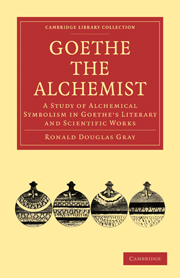VIII - Centre and Circle
Published online by Cambridge University Press: 10 November 2010
Summary
‘The difference between Goethe's writings and those of most other men of letters’, writes Barker Fairley, ‘is that wherever we touch him, in a lyric, or an epigram, or a novel, or a drama, or an essay, or a review, or a scientific monograph, or even in a letter, we cannot, unless we are indifferent to him, leave it at that, but are gradually, insensibly, involved, led on, started on a journey; and the journey, we find, though not a day's or a year's journey, but rather that of a lifetime, always points or leads to the common centre of experience in his mind and person, from which the whole of his immense production seems to radiate. It is this reference to a centre which gives Goethe's works their peculiar, their specifically Goethean character.’ Later, Professor Fairley adds: ‘This imagery of centre and circumference was clearly what he needed to describe the working of his mature mind because he used it so flexibly.’ This feature has been remarked by other recent critics. Gundolf speaks of Goethe's work as a sphere, in which the individual parts are radiating lines. Leisegang seeks to define his thought as ‘circular’, in contrast to the ‘linear’ thought of more logical thinkers.
- Type
- Chapter
- Information
- Goethe the AlchemistA Study of Alchemical Symbolism in Goethe’s Literary and Scientific Works, pp. 182 - 204Publisher: Cambridge University PressPrint publication year: 2010First published in: 1952



